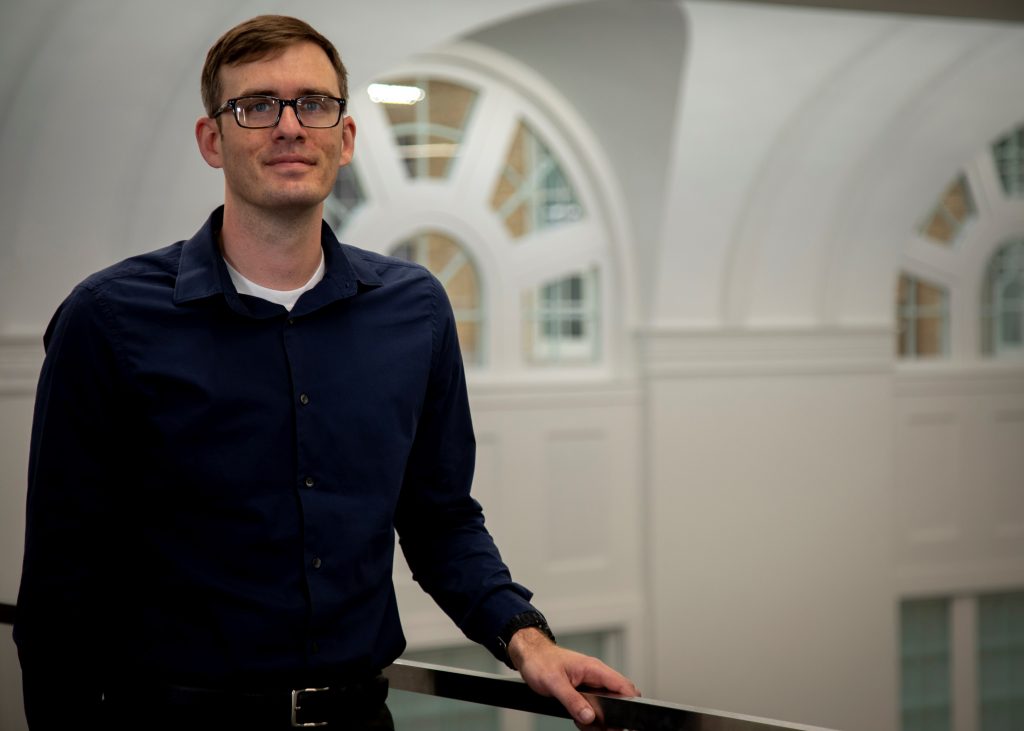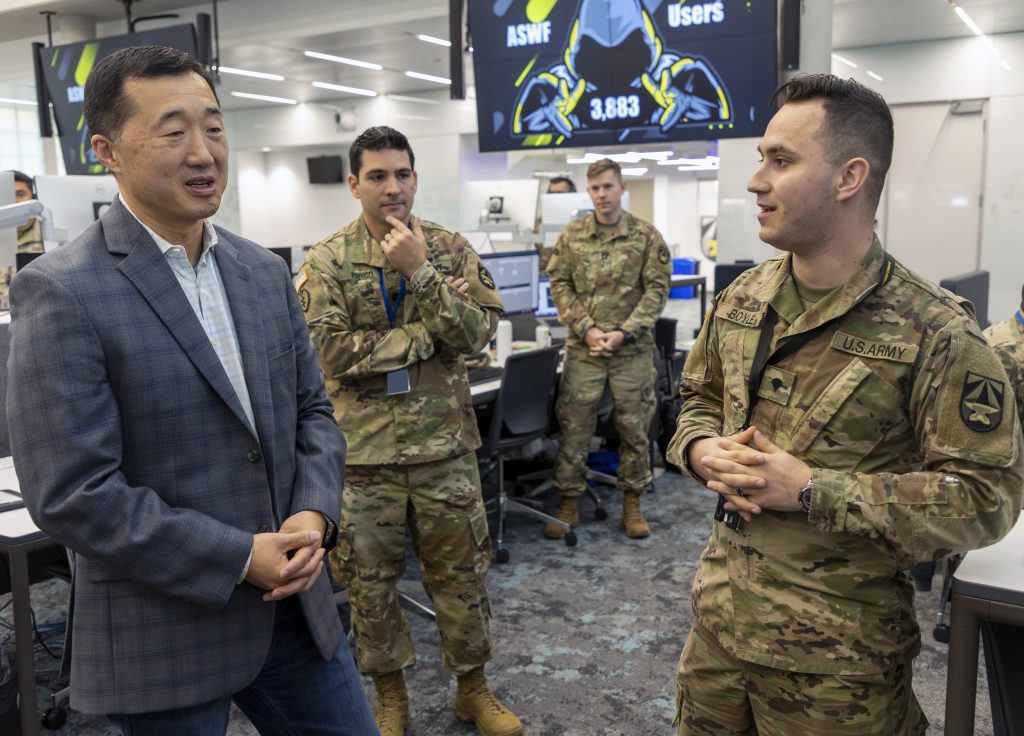
Capt. Keyshawn Lee of the Army Software Factory conducts software development activities from his workstation. (U.S. Army photo by Austin Thomas, Army Futures Command)
The Army Software Factory is hastening the Army’s ability to develop tech talent from within.
by Col. Vito Errico and Col. Jason Zuniga
The Army Software Factory is a first-of-its-kind initiative to develop transformational tech talent from within the Army’s existing ranks.
Situated on a community college campus in downtown Austin, Texas, the Army Software Factory draws in Soldiers and DA civilians who are eager to learn in-demand software development skills and apply them to persistent Army challenges.
The approach is innovative because it recognizes that many of the capabilities the Army will require in future battlefield settings, such as the ability to solve problems and troubleshoot new technologies without needing to call on external support, can be cultivated internally.
“The Army Software Factory is important not only because it confers modern software knowledge, but also because it exposes members of our force to increasingly creative and productive ways of thinking and problem-solving,” explained Matthew Flautt, chief technology officer at the Army Software Factory.
The command, which is responsible for producing the concepts, organizational designs and technological requirements that will enable the Army, as part of the joint force, to achieve overmatch in multidomain warfare, is a natural fit for the Army Software Factory because the talent development model it is piloting has implications for future force design.
“We will always partner with industry to deliver cutting-edge solutions to our Soldiers. However, a rapidly evolving digital age requires us to foster enhanced tech understanding and talent within our own force—both to remain nimble at the tactical edge and to ensure that members of our great Army can optimize their own talents and contributions to the nation without having to transition out of uniform,” said Master Sgt. Antraun Glover, the Army Software Factory’s lead noncommissioned officer.
KEEPING PACE WITH TECHNOLOGY
Providing additional pathways for learning and professional development to Soldiers and DA civilians can improve retention as well as recruitment, particularly when the education and training being offered is intensive, hands-on and as immersive as a private-sector alternative.
The Army Software Factory opened its doors in January 2021 and has since welcomed four cohorts and more than 100 members. A new cohort consisting of approximately 20 Soldiers and five DA civilians arrives every six months; cohort members, who are selected from a competitive pool of applicants, come from a variety of locations and military occupational specialties, bringing with them diverse backgrounds and insights.
Each individual who arrives to the Army Software Factory is expected to invest considerable energy and effort into the three-year program, which commences with a tech accelerator phase—combining classroom learning on the basics of coding and software development with tech expert mentorship—and advances through industry partner pairing, skills specialization and advanced knowledge application. Throughout the process, the program embraces tech industry best practices, such as imaginative brainstorming and openness to trying new ideas, to accelerate innovative solutions while also encouraging retention of top technical talent.
While the program is still new, the plan is to continue harnessing the talents Army Software Factory members develop long after they graduate the program, either through placement in tech-specific Army roles or by embedding tech-savvy personnel in Army organizations or units that could benefit from the expertise.
If “data is the ammunition of the future,” as defense officials have underscored, then the Army Software Factory provides a promising avenue for developing the technical experts needed to handle and deploy data on the ground, at the speed of relevance and against near-peer competitors who are also investing heavily in state-of-the-art warfighting technologies.

NO PAYNE NO GAIN: Chief Warrant Officer 2 Rob Payne pictured at the Army Software Factory. Prior to joining the Software Factory, Payne made a basic application for operators in his motor pool to digitize the maintenance process, which proved useful for his Soldiers, and underscored the benefits of having Soldiers participate directly in the digital tool development processes. (U.S. Army photo by Army Futures Command)
LEVERAGING SOLDIER INSIGHTS
The motto of the Army Software Factory is “By Soldiers. For Soldiers.” Brief and to the point, the phrase emphasizes one of the program’s greatest strengths: its ability to advance Soldier-centered design of digital tools and applications through the active participation of Soldier problem-solvers.
Many Soldiers arrive to the Army Software Factory having already completed multiple years of service. They include combat veterans, special forces members and West Point graduates. Some are brand new to the field of software development, whereas others have IT backgrounds. Regardless of their length of service or field of expertise, they each have unique insights that they are eager to apply.
By employing a learning-by-doing process, the Army Software Factory allows cohort members to tackle real-world Army challenges while simultaneously honing their software development skills. Anyone in the Army can submit a problem set for consideration through a portal available on the Army Software Factory website. If selected, a problem set will be assigned to a cohort member project team—supported by embedded software development expert trainers, who have experience working with leading tech companies—that will work on that problem set as a software application.
As cohort members progress in the program, they have the opportunity to focus on Agile and Lean Six Sigma management, user-centered design and various application and platform engineering disciplines. The Army Software Factory additionally keeps its members apprised of emerging trends in software, cybersecurity and cloud technologies through regular professional development sessions delivered by thought-provoking tech leaders and subject matter experts.
These activities are pivotal because they show cohort members and potential cohort members that, rather than needing to leave the Army to become software developers, they can grow professionally in a competitive field while staying in uniform (or while maintaining DA civilian status, as the case may be).
The Army Software Factory also holds promise for alleviating Army reliance on outside software development and troubleshooting support. Increased self-sufficiency will likely prove essential in future operational environments, where communications may be disconnected or dispersed across multiple domains. In such settings, having Soldiers capable of applying software development skills to remedy software problems that may arise will provide an important warfighting advantage.
ARMY INGENUITY
The strength and beauty of the system also lies in its ability to harness domain expertise present in participating Soldiers and DA civilians, many of whom already have years of Army service. An example of this is the story of Chief Warrant Officer 2 Rob Payne.
Payne enlisted as a Bradley Fighting Vehicle mechanic in 2008 and became a warrant officer to have a more direct role in improving processes and influencing maintenance operations.
He did just that by making the preventative maintenance checks and services process—a system of ensuring mission readiness by tracking and performing preventive maintenance on trucks and other rolling stock equipment—easier for Soldiers.
As Payne became more familiar with the Global Combat Support System – Army, he realized that maintainers were taking digital system output but using a pen-and-paper process to get updated preventative maintenance information back into the system. To improve this time-consuming and error-prone process, Payne taught himself elementary programming skills and made a basic application for operators in his motor pool to digitize the maintenance process. His application proved useful for his Soldiers and also highlighted the benefits of having Soldiers—particularly those with hands-on experience working with a given system—participate directly in digital tool development processes.
When Payne joined the inaugural cohort of the Army Software Factory, he had the opportunity to apply his experience as part of a Software Factory application problem.
“Oftentimes, the people who make software don’t have experience in the domain, which can result in software that doesn’t work or doesn’t meet the needs of the end user,” Payne shared in a conversation with Army Futures Command staff. He explained that his expertise in maintenance contributed to his team’s ability to produce an effective app.
After problem submission from Army Materiel Command, Army Software Factory produced a preventive maintenance application that can provide Soldiers with the resources they need, such as technical manuals and maintenance records, to perform preventive maintenance on equipment. The free app (available at https://pmcs.swf.army.mil/) is accessible from any Army employee’s personal device and could improve unit readiness and enhance Soldier experiences across all components of the Army.
The process illustrates how for individuals like Payne, the Army Software Factory offers a new opportunity for growth within the Army. At the same time, for the Army, Soldiers like Payne represent the possibilities of the future, and how empowering Soldiers and DA civilians to solve problems using new technology can make for a stronger overall Army.
The Army Software Factory’s focus on user-friendly apps signals new ways of thinking about and overcoming problems, as well as future new ways the Army can implement solutions at scale. The Army Software Factory is helping ensure innovation is shared across the Army, instead of taking place in silos.

Mr. Young J. Bang, Principal Deputy Assistant Secretary of the Army Acquisition, Logistics & Technology met with leadership and took a tour of the various facilities of Army Futures Command, April 14th-15th, 2022, in Austin, Texas. Photo by: Austin Thomas
CONCLUSION
The Army Software Factory is imagining and executing what a future force design and associated talent development could look like, specifically in the realm of software development and operations. This is noteworthy not only because the Army is exploring how to grow critical future skills from within, but also because it is exposing Soldiers and DA civilians to new, digital ways of thinking and problem-solving.
The Army’s strategic investments in initiatives like the Army Software Factory illustrate how leap-ahead modernization requires more than identifying and incorporating external solutions to Army challenges. To modernize extensively and sustainably, we must nurture modern talent that can advance systems internally. The brilliance of this approach is that it focuses on maximizing the potential of our most valuable and most readily available resource—people—to further Army modernization aims. This creates a force structure that is fortified by a collective vision as well as individual empowerment.
The Army Software Factory recognizes that in an Army that wants warriors, ensuring warriors feel wanted is paramount. Investing in new skills, encouraging critical thinking and empowering Soldiers to tackle Soldier-specific problems will help to build a future force that is as fulfilled as it is formidable.
The Army Software Factory aligns with a fiscal year 2022 Congressional mandate that the Department of Defense develop software competence in those who have the aptitude but lack formal education.
In addition to building a capability to design and produce software applications for Soldiers, the Army Software Factory serves as a champion for operationalizing cloud technology, Agile methodologies and development, security and operations (DevSecOps) simultaneously within the Army, as many Fortune 500 companies have done to enable digital transformation.
To learn more about the work of the Army Software Factory, to submit a problem set or to apply for an upcoming cohort, go to: https://armyfuturescommand.com/software-factory/.
COL. VITO ERRICO is the director of the Army Software Factory. He holds a Bachelor of Science degree from the United States Military Academy, a Master of Policy Management degree from Georgetown University, and a Master of Business Administration degree from Yale University.
COL. JASON ZUNIGA is the chief operations officer of the Army Software Factory. He holds a bachelor’s degree in engineering industrial management from the United States Military Academy and a Master of Business Administration degree from The Wharton School of the University of Pennsylvania.







